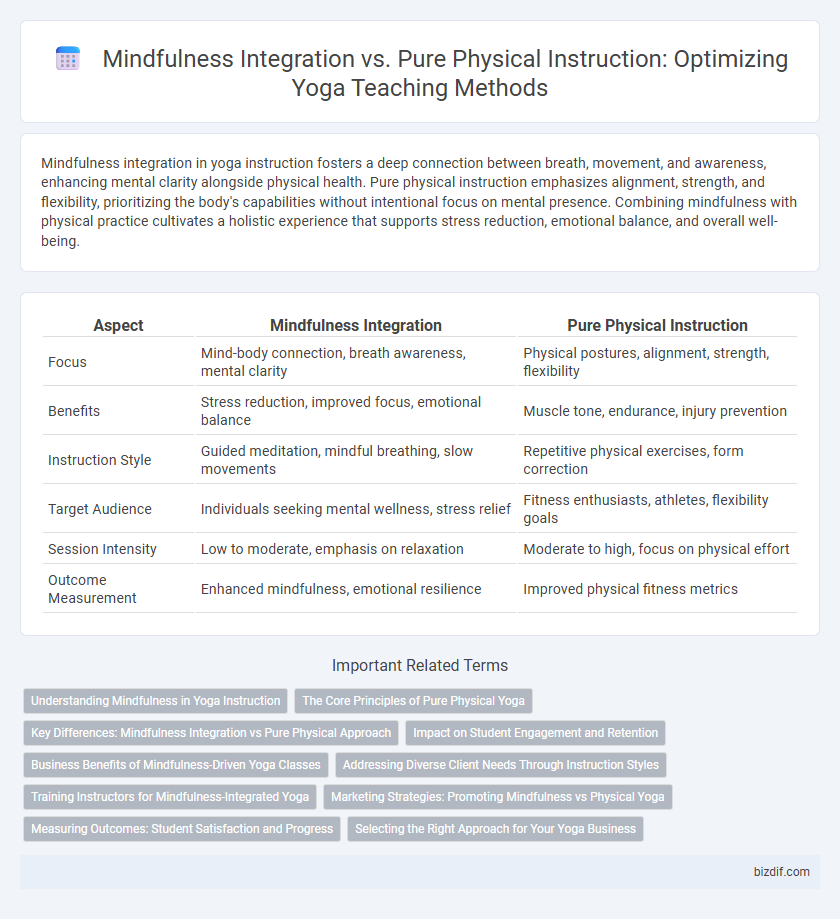Mindfulness integration in yoga instruction fosters a deep connection between breath, movement, and awareness, enhancing mental clarity alongside physical health. Pure physical instruction emphasizes alignment, strength, and flexibility, prioritizing the body's capabilities without intentional focus on mental presence. Combining mindfulness with physical practice cultivates a holistic experience that supports stress reduction, emotional balance, and overall well-being.
Table of Comparison
| Aspect | Mindfulness Integration | Pure Physical Instruction |
|---|---|---|
| Focus | Mind-body connection, breath awareness, mental clarity | Physical postures, alignment, strength, flexibility |
| Benefits | Stress reduction, improved focus, emotional balance | Muscle tone, endurance, injury prevention |
| Instruction Style | Guided meditation, mindful breathing, slow movements | Repetitive physical exercises, form correction |
| Target Audience | Individuals seeking mental wellness, stress relief | Fitness enthusiasts, athletes, flexibility goals |
| Session Intensity | Low to moderate, emphasis on relaxation | Moderate to high, focus on physical effort |
| Outcome Measurement | Enhanced mindfulness, emotional resilience | Improved physical fitness metrics |
Understanding Mindfulness in Yoga Instruction
Mindfulness integration in yoga instruction emphasizes cultivating present-moment awareness and deep connection between breath, body, and mind, enhancing the overall practice experience. Pure physical instruction focuses primarily on alignment, strength, and flexibility without intentional guidance toward mental clarity or emotional balance. Understanding mindfulness in yoga empowers practitioners to develop emotional resilience, reduce stress, and foster holistic well-being beyond physical postures.
The Core Principles of Pure Physical Yoga
Pure physical yoga centers on the core principles of alignment, strength, and flexibility, emphasizing precise postures and controlled movements to enhance bodily awareness. Instruction prioritizes breath synchronization with motion, fostering muscular engagement and endurance while minimizing injury risk. This approach cultivates a disciplined physical practice that strengthens the body's foundation without integrating the broader mindfulness or meditative aspects typically found in holistic yoga styles.
Key Differences: Mindfulness Integration vs Pure Physical Approach
Mindfulness integration in yoga emphasizes the connection between breath, body awareness, and mental presence, fostering holistic well-being beyond physical flexibility and strength. Pure physical instruction prioritizes alignment, posture correction, and muscle engagement without explicit attention to mental states or emotional regulation. Key differences lie in the focus on cultivating present-moment awareness and stress reduction versus primarily enhancing physical fitness and technique.
Impact on Student Engagement and Retention
Mindfulness integration in yoga instruction significantly enhances student engagement by fostering deeper mental awareness and emotional connection during practice, which pure physical instruction often lacks. Studies show that students practicing mindfulness-based yoga report higher satisfaction and are more likely to maintain consistent attendance over time. This holistic approach cultivates long-term retention by addressing both physical and psychological dimensions, creating a more fulfilling and sustainable yoga experience.
Business Benefits of Mindfulness-Driven Yoga Classes
Mindfulness-driven yoga classes enhance client retention by fostering deeper mental and emotional engagement, leading to consistent attendance and long-term loyalty. Businesses benefit from increased word-of-mouth referrals and higher class satisfaction scores, as mindfulness promotes stress reduction and holistic well-being beyond physical fitness. Incorporating mindfulness techniques differentiates yoga studios in competitive markets, attracting a broader demographic seeking comprehensive lifestyle transformation.
Addressing Diverse Client Needs Through Instruction Styles
Mindfulness integration in yoga instruction enhances client experiences by combining physical postures with breath awareness and mental focus, promoting holistic well-being and stress reduction. Pure physical instruction centers on alignment, strength, and flexibility, appealing to clients seeking targeted fitness outcomes or rehabilitation. Tailoring instruction styles to individual client goals and preferences ensures diverse needs are met, fostering engagement and sustained practice.
Training Instructors for Mindfulness-Integrated Yoga
Training instructors in mindfulness-integrated yoga enhances their ability to guide students beyond physical postures by cultivating present-moment awareness, emotional regulation, and holistic well-being. Mindfulness integration in yoga instruction promotes a deeper connection between breath, movement, and mental clarity, which pure physical instruction often overlooks. Emphasizing mindfulness during instructor training results in more effective teaching strategies that support stress reduction, improved focus, and sustainable yoga practices for diverse student populations.
Marketing Strategies: Promoting Mindfulness vs Physical Yoga
Marketing strategies for promoting mindfulness-focused yoga emphasize the mental and emotional benefits such as stress reduction, enhanced focus, and emotional balance, appealing to individuals seeking holistic wellness. In contrast, campaigns centered on physical yoga highlight flexibility, strength, and weight management, targeting fitness enthusiasts and those aiming for physical transformation. Tailoring content with keywords like "mindfulness meditation," "stress relief," and "physical fitness yoga" enhances search visibility and attracts niche audiences effectively.
Measuring Outcomes: Student Satisfaction and Progress
Mindfulness integration in yoga instruction enhances student satisfaction by fostering deeper body awareness and emotional regulation, leading to measurable progress in mental well-being alongside physical improvements. Pure physical instruction primarily focuses on flexibility and strength gains, which show clear but limited outcome metrics tied to physical performance alone. Tracking student progress through self-reported mindfulness scales and physical ability assessments provides a comprehensive view of overall development in both instructional approaches.
Selecting the Right Approach for Your Yoga Business
Choosing between mindfulness integration and pure physical instruction depends on your target audience and business goals in the yoga industry. Mindfulness-focused classes attract clients seeking stress reduction, mental clarity, and holistic well-being, while pure physical instruction appeals to those aiming for improved strength, flexibility, and fitness. Tailoring your approach with clear branding and marketing strategies enhances client retention and business growth in the competitive yoga market.
Mindfulness Integration vs Pure Physical Instruction Infographic

 bizdif.com
bizdif.com